Churches
Our Lady Star of the Sea (Delancey)
History
Synopsis
The History of the parish of Our Lady Star of the Sea dates back around one hundred and twenty years ago. At the time of the potato famine many Irish people came to work in Alderney and Guernsey, soon to be joined by their families. An Irish colony soon grew up in St. Sampson’s and the Vale, but they were without a Church or a school. The Irish settlers and the local people, through their hard work and sacrifices, have achieved remarkable results; an attractive little Church, a fine Primary School and a Parish Centre for an ever-growing Catholic Community.
Parish life is an adventure full of surprises and Our Lady Star of the Sea has had her fair share. Events of life can be complicated and following God’s will can be difficult. Like the family that prays together, so the parish that prays and works together can continue the great journey into the future. Such a parish is Our Lady Star of the Sea, Delancey, Guernsey.
In the Beginning
The church of Or Lady Star of the Sea was founded by a small group of Irish immigrants who fled during the great famine in Ireland during the 19th century. About this time the British government wished to build a breakwater in Alderney (now famed for being very long for such a small island). Many Irishmen brought their families there and worked for the Admiralty, thus assuring themselves of food and livelihood. Large quantities of granite (a stone for which Guernsey is well known) were needed to achieve the breakwater, and many of the Irish then moved here to work in the quarries production the stone required for such a large undertaking.
Thus an Irish community grew up in the parish of St Sampson’s and the Vale. However for them there was no Church or school, as Catholicism was not the state religion of the island. Sundays saw a four-mile walk to the Catholic Church of St. Josephs, in St. Peter Port parish. Here Mass was said by the Parish Priest for all of Guernsey, Father Guedez. About this time one Miss Kelly opened a small school for Catholic children in the area, in her house in Brock Road, St Sampson’s.
Father Guedez’s health was failing and the Bishop of Southwark, the Diocese to which the island then belonged, sent a young priest to assist him. Father William Foran saw the need for a Chapel of Ease in St. Sampson’s, and duly a cottage and field in the Rue de Mont, Delancey were purchased. To this day the Church stands on the same site and details of the original architecture may still be seen. The original Church, erected by the parishioners under the guidance of Father Foran could be used for school on weekdays and Church on Sundays. The original building was from the entrance of the present Church to the sanctuary, which used to be enclosed by a curtain. The body of the building was divided into two classrooms. The fireplace and chimneys may still be seen on the southeast side of the Church, as alcoves for statues, one of Mary herself and the other of St Joseph. The Irish colony was now well established, and the building was opened late 1879. The people of Delancey are very proud of their Church built in hard Guernsey granite, a symbol of “upon this rock I will build my church.”
As a constant stream of Irish families arrived to join friends and relatives, numbers grew and it became necessary to extend the school. A large building was erected on the northern side of the Church, as the main school. This is still in use as the parish centre. The small school for the infants, built south of the Church, was unfortunately lost in a fire in 1910.
In 1868 Father Amadeus Guedez asked the Bishop of Southwark to help establish a Community of Nuns in Guernsey, and this was soon carried out with the impetus of the Mother Superior of the Brighton Convent of Mercy. The formal agreement was drawn up between the Bishop, Father Guedez and Mother Angela Graham. When the community was established two nuns would walk from the convent in St. Peter Port to teach in the school, and Sisters of Mercy are still to be found teaching there to this day.
At that time a curate from St. Joseph’s would say Mass twice in the week and on Sundays at Our Lady Star of the Sea.
By the turn of the century Father Foran had become Canon Foran, and a retired priest from Liverpool, Canon Franklin, then helped him. With the Bishop of Portsmouth’s approval Canon Franklin bought in 1902 a large house called Delancey Villa from Mr Gervaise Peek, with his own money. This is still the Priest’s House though it is now let out to rent, as Delancey does not have a resident Priest at the present time. Canon Franklin took over the care of Delancey, until he died on 11th June 1916.
Father Thomas Hickey, a Guernseyman, succeeded him. He realised the difficulties of Guernsey Catholic schools compared with English, and, determined to try and improve their status, he stood and was elected a Peoples Deputy in the States of Deliberation of Guernsey. At this time the States paid 6/11th of the salaries of teachers in Voluntary schools, and half the cost of maintenance. The rest of the costs had to be found by the parishioners and benefactors. This changed, such that the States paid all the salaries, unburdening parish councils from some if the taxes they had to levy. However this did not immediately apply to Catholic and Voluntary schools. Canon Hickey, from his seat in the States spoke up for the Voluntary schools and was successful in his amendment to include the Catholic schools with the parish schools in this change. This was achieved with help from Jurat John Roussel and Deputy (later Bailiff) Ambrose Sherwill, and covered the schools of St. Joseph’s, Delancey and Notre Dame. Father Hickey later became a Monsignor Canon. One half of maintenance expenditure of the school remained to be found and bazaars were held annually to raise funds, supported by the ladies of the parish. These are generally successful socially and financially, and continue to the present day.
Golden Jubilee
On September 26th 1929 Our Lady Star of the Sea, Delancey celebrated its Golden Jubilee. Bishop Cotter of Portsmouth, the Diocese to which the Channel Islands now belonged, visited to preside over the celebrations. Delancey Park had been placed at the disposal of the Jubilee Committee and an altar was built there at which the Bishop celebrated Pontifical High Mass. Thousands of islanders both Catholic and non-Catholic were present, and every word spoken and sung was relayed to the fringes by a new technology, microphones and loudspeakers. The celebrations continued all day, involving the school, which put on a concert that impressed the Bishop. The words ‘Golden Jubilee’ were spelt out in paper letters and 13 youngsters carrying these letters recited a poem. Some parishioners even remember this event today.
Not long afterwards, in 1933, Sister Mary Gabriel, who with Sister Mary Angela spent 30 years in the parish teaching and looking after the school, celebrated her Golden Jubilee as a professed nun.
Occupation
Soon afterwards the young Irish priest Father William Kirk, who remained with the parish through out the German Occupation succeeded Father Philips.
The Second World War began in September 1939, and in 1940 the German forces occupied the Channel Islands. The Occupation continued for 5 years but Delancey kept up its spiritual life. The children who were not evacuated were educated in the State system, while instruction in the faith was given by the lay of the
parish.
Members of the German forces working as ordinary soldiers in hospitals and light houses who were priests were given permission to use the Church to say Mass. As all German soldiers always carried their arms it was a strange sight to behold a priest approach the altar carrying a chalice and his bayonet.
On 21st June 1940 thousands of Islanders were evacuated, including 6000 school children, of which 68 were under the care of Delancey Primary School and Sister Mary de Sales. They made the hazardous sea journey to Weymouth. From there their final destination was Winsford, Cheshire, where they spent the next five years. Due to the care and support of so many people in and around Winsford the children’s lives were helped to seem as normal as possible. The people of Winsford opened their hearts and homes and became mothers and fathers to these young children. There was no Catholic Church in Winsford, so a room at the Guildhall was offered to Sister de Sales, where Mass was offered by Father Bleach, a Salesian father serving in Guernsey at La Chaumiere (a Chapel of Ease) at the time of the evacuation, he lived at Knutsford and travelled the 17 mile round trip to achieve this every Sunday. Meanwhile school was housed in the Church hall.
By 1946 most of the evacuees had returned and school in Guernsey had reopened. Throughout the years of occupation and evacuation the children – some now young adults – kept their faith and Catholic identity.
In 1949 an army chaplain Father Stanley Terry served Delancey, and Father Edward Casey succeeded him in 1952. It was during this time that Delancey became a Parish in its own right. Father Casey encouraged the parishioners in this status and plans progressed to enlarge the church. When the work was finished the church became twice as big, attendance at Mass increased and Delancey still hasn’t looked back.
During the 1950’s Father Francis Philips returned to Guernsey to be Parish Priest and Catholic Dean of Guernsey in charge of St. Joseph’s Church. After 10 years at St. Joseph’s it was a joyful return when the now Canon Philips decided to retire and spend his remaining years at Delancey.
In the 1960’s and early 1970’s the parish was once more represented in the States. This time it was by parishioner and Deputy, Reginald Harvey, a man of the people who fought injustice at every corner. Catholic education owes him too a great debt, for it was through his efforts the States voted to pay the Catholic authorities rent for using their buildings. In the same period Deputy Harvey was also instrumental in States’ decision to allow Catholic girls who received special places in the 11 plus to take up their scholarships at Blanchelande Convent, with the education Council paying the college fees.
The 1960’s saw the reordering of the interior of Delancey to conform to Vatican II, and the honouring of two parishioners for their work. Deputy Reginald Harvey and Mrs Gertrude West both received the Papal award pro ecclesia and pontifice medal.
A New School
The then Bishop of Portsmouth, Bishop Worlock, visited Delancey in 1968. After much discussion it was decided that Delancey and the small school at Ker Maria would join to form a primary school. It was felt that this should be housed on one site, as the location of the infants at Ker Maria, 2 miles from the juniors at Delancey was making it difficult to run. With the help of a diocesan loan the land adjoining the Priests House was purchased and plans went ahead to build a new school to be called St. Mary and St. Michael Primary School. Unfortunately Canon Philips dies in February 1972 without seeing the achievement of his 200 regular churchgoers, the new school. It became clear that the loan would only allow for the building of an infant school, and that the juniors would have to remain in the old buildings, until more funds were available.
About this time the Sacred Heart Fathers of Betharram offered the diocese the loan of some of their priests, and Father Philip Ilsley came to Guernsey. Two young men of the parish chose the priesthood. Canon David Mahy; Catholic Dean of Jersey, and Father Vincent Harvey; Catholic Dean of Basingstoke and vocations officer for the diocese of Portsmouth. Our Lady Star of the Sea was now approaching its centenary. Bishop Emery visited the parish on 26th September 1979 and celebrated Mass for the parishioners.
Work commenced on the new infants school in the early 1980’s, and it was blessed and opend by Bishop Emery in 1982. All that remained was to repay the loan to the diocese. By the middle of the 1980’s it was apparent that the school was overcrowded, as children from other areas were attending the Catholic school in the north. Father Ilsley encouraged the people to look to the future, pray and put their trust in God. Ill health over took Father Ilsley and he retired to his community in Birmingham in 1988 to be succeeded by another of his order, Father Cyril Hazlewood S.C.J.
With Father Hazlewood’s experience in administration and the help of parishioners with financial expertise the debt was being reduced and the parish could think of continuing with phase two.
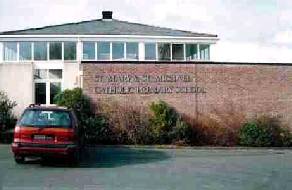 Early in 1989 Father Hazlewood was approached by a parishioner who wished to help the school with a gift of a large sum of money, enough to build the complete juior school. Work started straight away to complete St Mary and St Michael Catholic Primary School. The junior school was blessed and opened by our present Bishop, Crisopian Hollis, on the 15th September. The benefactor was thanked, and a small plaque built into the school wall commemorates the benefactor’s sister, Miss Bertille Feuillerat.
Early in 1989 Father Hazlewood was approached by a parishioner who wished to help the school with a gift of a large sum of money, enough to build the complete juior school. Work started straight away to complete St Mary and St Michael Catholic Primary School. The junior school was blessed and opened by our present Bishop, Crisopian Hollis, on the 15th September. The benefactor was thanked, and a small plaque built into the school wall commemorates the benefactor’s sister, Miss Bertille Feuillerat.
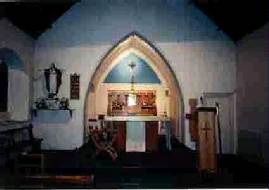 During 1994 through another gift the parish debt was completely cleard. Delancey now has a beautiful little church, a modern primary school, a parish centre and a priest’s house. The people of the parish have a good community spirit and realise that all assests must be maintained. A management committee and parish council support the priest and work goes ahead to help families education their children in Catholic values.
During 1994 through another gift the parish debt was completely cleard. Delancey now has a beautiful little church, a modern primary school, a parish centre and a priest’s house. The people of the parish have a good community spirit and realise that all assests must be maintained. A management committee and parish council support the priest and work goes ahead to help families education their children in Catholic values.
New Roof and Windows
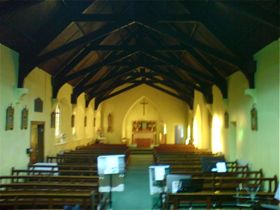 Fund raising began once more to enable vital repair work to begin on the roof. This was completed in 1996.
Fund raising began once more to enable vital repair work to begin on the roof. This was completed in 1996.
10 new windows were also installed in the church in 1994 owing to the deterioration of the pervious windows over 100 years. The new windows were made by the Abbey Stained Glass Studio in Dublin, and was the first phase of the project to replace all existing windows.
The Refurbished Sanctuary
Lawrence Malcic, Architect
In the summer of 2007 Our Lady Star of the Sea has again been renovated. The entire church has been refurbished, and new furniture for the sanctuary has been specially designed and made in Guernsey. A strong central focus has been created for the new sanctuary. Aligned on the central axis of the church are the altar,
tabernacle and crucifix.
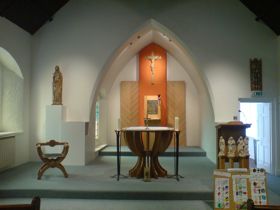 The altar is constructed from white oak that is fashioned into 12 sculpted supports representing the 12 apostles gathered around and supporting the holy table of the Last Supper. The altar is circular to emphasise the gathering of all the faithful to the Eucharist. The profile of the 12 supports, when viewed together, reminds the eye of the Eucharistic chalice that holds the precious blood of Jesus, just as the white circular Italian Carrara marble top of the altar symbolises the bread transformed into the body of Christ.
The altar is constructed from white oak that is fashioned into 12 sculpted supports representing the 12 apostles gathered around and supporting the holy table of the Last Supper. The altar is circular to emphasise the gathering of all the faithful to the Eucharist. The profile of the 12 supports, when viewed together, reminds the eye of the Eucharistic chalice that holds the precious blood of Jesus, just as the white circular Italian Carrara marble top of the altar symbolises the bread transformed into the body of Christ.
Directly behind the altar, a simple oak pedestal contains the art-nouveau brass tabernacle that has long resided in Our Lady Star of the Sea. Behind it, rising from floor to ceiling is a shimmering panel of silk. The silk is woven of red and gold thread; the red represents the blood of Christ, the gold his triumph as Christ the King. As it tapers upwards into the pointed arch, it can symbolise the “tongues of fire” of the first Pentecost. The silk panel is flanked by white oak panels constructed in chevron patterns that suggest pairs of hands raised in worship.
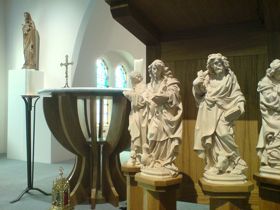 The lectern, constructed in oak, has statues carved in Germany from white maple representing the four evangelists. Each saint is represented preaching, and each is identified by his iconographic symbol: St. John with an eagle, St. Luke with an ox, St. Matthew with an angel and St. Mark with a lion. On the Presider’s Chair the carved rose motif symbolises the Blessed Mother, and behind the chair is a fine wood carving of the Madonna and Child.
The lectern, constructed in oak, has statues carved in Germany from white maple representing the four evangelists. Each saint is represented preaching, and each is identified by his iconographic symbol: St. John with an eagle, St. Luke with an ox, St. Matthew with an angel and St. Mark with a lion. On the Presider’s Chair the carved rose motif symbolises the Blessed Mother, and behind the chair is a fine wood carving of the Madonna and Child.
The use of natural materials – wood, silk, marble – conveys a sense of the authentic in the design. The simple, pure composition creates a place of serenity that focuses attention on the mystery that occurs at each celebration of the Holy Mass.